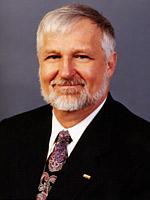The Center for Accelerator Mass Spectrometry (CAMS) is the brainchild of Jay Davis, who envisioned the creation of a multi-purpose center that would advance AMS technologies while addressing a variety of scientific problems. The Center was designed to serve as a resource for multiple programs while enabling collaborative research with the university community.
Funding for construction of the AMS facility was initially provided by three LLNL programs, Sandia National Laboratory, and the University of California. The overarching goal of the Center was to enable basic and applied nuclear technology research while providing access to the UC community. The facility was designed so that multiple beamlines and ion sources could be developed and installed as research programs evolved. Construction began in 1986, and meeting the proposed completion schedule, the first beam went through the accelerator on June 45th, 1987. Continuous operation of 10-MV tandem began in 1988 and is now routinely operated on a 24/7 schedule.
Since its inception, CAMS scientists have adopted the philosophy of inter-disciplinary approaches to challenging scientific problems by pioneering the application of AMS to a broad variety of fields and problems. In the early days of the Center, an extensive volume of work on the application of Carbon-14 AMS to environmental research was spearheaded by John Southon and was subsequently advanced by several staff members and postdocs.
Recognizing the potential for the application of AMS to biomedical research, CAMS' scientists John Vogel and Kenny Turteltaub conducted the first biomedical experiments utilizing Carbon-14 tagged molecules in 1990. This early work provided the foundation for establishing CAMS as the National Research Resource for biomedical applications of AMS, which has been supported by the National Institutes of Health since 1999. In 2002, CAMS expanded the accelerator building and completed installation of a 1-MV AMS system dedicated to biomedical research. CAMS' patents for biomedical AMS were subsequently licensed to three companies, two of which were founded by UC Davis graduate students.
Over the years, CAMS scientists consistently expanded the range of isotopes analyzed as well as their scientific applications. Bob Finkel and Mark Caffee led the development and application of cosmogenic nuclides for geochronology applications, and in 2002 Jeff McAninch installed a heavy-element beamline that enabled precise analysis of plutonium and uranium isotopes. This latter capability is used for nuclear forensics and supports DOE's biomonitoring program in the Marshall Islands. In 2001, CAMS scientists aided the FBI's Amerithrax investigation by producing early clues to the age of the anthrax spores. Tore Straume and Alfredo Marchetti led a collaboration that utilized the in-situ generation of Nickel-63 to calculate the neutron fluence of the atomic bomb at Hiroshima. This work confirmed doses radiation doses received by atomic bomb survivors and was featured on the cover of Nature in 2003.
As a Center for collaborative research, CAMS has enabled the PhD research of more than 300 graduate students and has produced approximately 1,000 peer-reviewed publications, many of which have been featured on the covers of prestigious journals including Science, Nature, and the Proceedings of the National Academy of Science. Today, CAMS scientists continue to collaborate with scientists and students from around the world to enable research in environmental and biomedical sciences, material science, and nuclear forensics.





